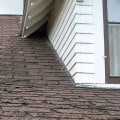Let's take a look at all the layers that are part of a roof and their purpose, insulation. The first layer of your roof will always be your roof covering (also known as roof covering). The roof covering is the wooden boards (plywood or boards) that form the frame of your roof. The drip edge is a metal stopper installed on the edges of the roof (eaves and rakes) to keep water away from the fascia and prevent it from entering underneath the roof components.
If the roof has no dripping edges, water enters behind the gutters and rots both in the fascia and on the roof cover. In reality, it is a code that indicates that the roof must have dripping edges and that it is properly installed. Unfortunately, some roofing contractors cut costs by leaving the dripping edge to reduce their prices, or are too lazy to install it properly. The ice and water shield is a waterproof membrane used to protect the roof from damage caused by ice and water.
Its main purpose is to protect your roof cover if water gets under the roofing material (asphalt, shingles, metal roof, etc.). Roof subfloor is a felt material (15 pounds, 30 pounds or synthetic) for roofing that is placed between the roof cover and the tiles. It is installed directly on the roof cover and provides an additional layer of protection against the elements. Beginner shingles are a pre-cut row of roofing material that is placed below the first row of tiles before installing them.
It ensures that there is roofing material between the joints, where the tiles bump into each other at the edges of the roof. Shingles for beginners also have an adhesive to ensure that the first row of tiles is sealed on the eaves and along the rakes. This seal helps improve the roof's resistance to strong winds. Most often made of plywood, this roof layer is installed above the frame in a typical roof installation.
Provides structure by joining beams and joists. You can usually see the underside of the plywood cover from the attic. This thin material is used to draw water away from where the chimney or siding elements and the roof elements intersect. The joint cover is generally made of metal, such as galvanized steel, aluminum or copper.
It tends to fail sooner than shingles, and should be inspected regularly to ensure that your home has an airtight seal. These specialized shingles cover all the edges of your home's roof. They are installed after the roof cover and before the subfloor. Its purpose is to seal the edge of the roof, which significantly increases the roof's ability to withstand strong winds and wind-driven rain.
This felt, or rubberized asphalt sheet, provides an additional layer of protection between the shingles and the roof terrace. Helps reduce detachment by allowing shingles to be flatter and more uniform. In addition, it prevents rain caused by the wind from penetrating under the tiles and causing damage to the roof structure or the interior of the house. Herpes zoster is the element with which most homeowners are familiar, since it is the layer that can be seen from the outside of their home and is an important aesthetic aspect.
Asphalt shingles come in two main types, 3-tab and architectural. Architectural tiles make up the majority of roof replacements today, since they cost only slightly more than the 3 tabs and come with much higher specifications and guarantees. However, typical shingles cannot cover ridges well, so this specialized extra-long shingle is installed along the ridge of a sloped roof. It is placed on the joint between these two edges to keep rain and snow out of the house and, at the same time, allows hot air to escape.
Ridge plugs also complete the look of the roof by creating a hermetically sealed joint along both sides. Starter Strip shingles are a strip of shingles that cover each edge of your home's roof. Most tiles with a starting strip have an adhesive strip applied at the factory that helps to speed up installation time and prevent the tiles from peeling off. Not only are starter strips a more cost-effective alternative to using hand-cut tiles, but the adhesive ensures that the tiles are perfectly aligned, making it easier to install a roof with straight lines and does not require dangerously cutting access tiles from the edge of the roof.
Some roofing contractors often prefer to keep their customers informed regarding the many layers that make up a solid, reliable roof. So we'll start at the bottom of the terrace and continue climbing all the layers of the roof until we reach the tiles and the sunlight on the roof. This is the top layer of your roof system and will be the type of roofing material you choose (asphalt shingles, metal roofs, cedar roofs, synthetic roofs, etc.). It is the material found between the structural components of the roof (beams and trusses) and the insulating and waterproofing layers (roof materials, coatings, etc.).
It sits underneath all other roofing materials and works to provide an additional layer of protection against inclement weather. The roof covering is the roof layer (also called coating) that is installed between the beams (26%), the beams and the subfloor layer in a typical roof installation. Whether you're just curious or you're getting ready for a roofing project, you don't want to be surprised by the different materials (layers) you'll have to pay for when buying a new roof. You're usually not interested in the layers of the roof that keep your house dry until you have a problem, such as light entering the attic or ice accumulations in winter.
If you're cleaning your gutters, you probably have a bird's eye view, but you don't realize that there are many layers that make up your roof. . .











